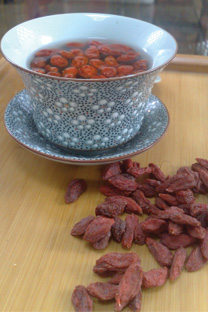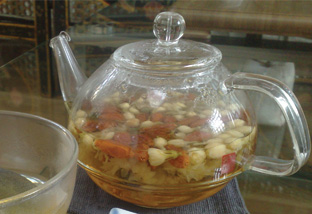Is this tea?

Bright eyes and alert mind – the sweet and nutritious Goji Berry ‘tea’
The past week or so has been very challenging for me. I’ve been very busy preparing for teanamu’s first market stall in Covent Garden on 20 August (Thursday). Working out what the crowd at the market would like: the sweet pastries for the afternoon crowd, savouries for the lunch time crowd. Also going through in my mind all that could possibly occur at the stall – How am I going to boil water for tea if there is a power cut? How do I keep my savouries warm? Would the crowd like a bit of simple homemade pastry or are they daring enough to try my tea-inspired sweets? Do I need a banner? How about coordinated t-shirts and aprons? How do I perform a tea appreciation demonstration? The list of questions buzzing in my head is endless.
On top of that, I have been busily programming the teanamu e-shop in time for the market stall, preparing the tea packaging, printing tea information cards to go with the tea, and planning loads of activities around my tea appreciation workshops etc.
All these projects are wearing me out a little and perhaps explain why I feel under the weather. My mom, although very sympathetic, seems to think I can only blame myself and that I should relax and take a breather. When I said I can feel a tickling itch at the back of my throat, she advised me to quickly brew some chrysanthemun tea. When I then said I’m lacking energy, she told me to brew up some ginseng tea. And when I said my eyes feel tired from staring at the computer screen, she said, ‘Make some goji berry tea!’

The lovely floral aroma from the jasmine and chrysanthemum combined with the hint of citrus from the goji berry is very refreshing and invigorating.
So I’ve dutifully started this morning off with a lovely medley of chrysanthemum, jasmine and goji berry concoctions, placed right by me next to my laptop, and I feel a bit as if my mom is here with me instead of thousands of miles away!
I’m inspired now by this experience to put up a quick post about “non-teas” and proper tea terminology. Strictly speaking, any infusions that don’t contain leaves from the camellia sinensis tea plant can’t be considered tea. So your “rooibos tea” is not tea, your “mint tea” isn’t tea and your “camomile tea” certainly isn’t tea! In Chinese they all would be called 非茶之茶 (fei cha zhi cha or “non-tea” tea).
Diverting from the issue of “non-teas” for a moment, jasmine tea is a fascinating case. A real, scented jasmine tea must have been scented during the manufacture of the tea with fresh jasmine flowers, rather than merely having jasmine flowers, essence or oil added after the tea is ‘finished’, i.e. all the normal tea making processes completed. Many cheap jasmine teas are in the latter category; you’ll probably recognize them by the small, dark brown to black, tea fragments, including stalks and stems, and the very heady aroma of chemicaly processed jasmine.

The sweet Rose and Honey Date ‘tea’ helps with digestion.
I am not one to disparage “non-teas”, for these infusions have had a long history of use in the Chinese culture. I, for one, was brought up with all sorts of interesting infusions and concoctions, which I now understand have absolutely legitimate uses (even if pedantic tea masters get their knickers in a twist when the word “tea” is wrongly bandied about!) Jasmine is known to soothe and relieve an anxious mind, aid digestion and support respiratory ease. Goji berries are known to have excellent restorative properties, improving eyesight, liver function and many effects of ageing. for the eyes (and anti-aging!) and liver. Like jasmine, chrysanthemun has detoxifying properties, and calms and soothes the tired mind.
One must be a little bit careful about consuming these substances. Chrysanthemum, for example, is very yin in nature and therefore unsuitable for women during periods or pregnancy. It is also not appropriate for people with a weak stomach. Jasmine flowers, likewise, are not suitable for consumption during pregnancy.
This is encroaching on the huge subject of Traditional Chinese Medicine. It is impossible to cover a lot of these home remedies and their medicinal properties in one single blog. Write and tell me if you’d like me to put up more posts about this topic in the future. I also have an article on the yin and yang balance that you can read here.
Take good care and hope to see you all on 20 August at the piazza market in Covent Garden! We’re there all day from noon onwards!
Here are some of the brews that my mom would make for the family:
Chrysanthemum Summer Cooling “tea” for those particularly hot days when we could be especially crabby and irritable:
Prepare equal quantities of dry chysanthemum, dry jasmine and goji berries – put all the ingredients into a tea pot and add boiling water. Allow to infuse for 5 min. Drink hot.
Goji Berry “tea” for those tired and puffy eyes:
Put 5g of goji berries into a mug and pour on boiling water. Allow to infuse 5 min. Drink hot. Continue to infuse, as desired, several times over the course of day.
Or put 50g goji berries in a pot, add about 1 litre of cold water, bring to a boil and leave to cool. Put in fridge for a refreshing cold drink.
Ginger Chinese Date “tea” for cold coughs:
3 thick slices of young ginger (bruised), 7 Chinese dates (stoned) and 250ml water in a pot and bring to a simmering boil for 15 min. Brew for 15min. and drink warm.
Jasmine Satsuma “tea” is great for indigestion or headaches:
Infuse 6-8 dry jasmine flowers in boiling water for 3 min. Add 30ml of satsuma juice, 1tblsp of honey and 300ml water. Enjoy!
Rose and Honey Date “tea” is very good for indigestion and will calm an upset stomach:
Infuse 1 chinese honey date in half a glass of boiling water for 6-8min. Top up with more hot water and add dry rose buds. Infuse for 2min and sip it slowly while hot.
Sugar Cane Water Chestnut “tea” – a very yin and soothing tea, suited to those of us whose constitution is perhaps not strong enough for other “cooling teas”:
Bring 600g sugar cane (washed and cut into 10-cm lengths), 100g candied winder melon strips, 25g fresh water chestnuts (peeled) and 2 litres of water to a simmering boil for about 1 hour.
Drink warm.
Warmly,
Pei
pei@teanamu.com
~~ sip a good brew, steal a slice of tranquility, glimpse a lingering fragrance, gladden the heart and refresh the mind ~~


Having got you into this, I’m so sorry I won’t be around to help/ visit your first day on the stall but I know you’ll have fun, learn lots and make a success of it.
I am looking forward to helping you out on your September date.
I have a lot of respect for both Chinese Traditional Medecine and Indian (Ayurvedic) and other traditional medicine/ health knowledge bases. Sometimes we have a tendency in the modern world to assume that our ancestors were ignorant peasants when it came to understanding the body and how to treat/ look after it. But there is infact much wisdom accumulated over millenia and it’s becoming clearer and clearer that modern western medicine can also learn from these older knowledge bases.
Pei, thank you for writing an interesting post. I’ve been reading your blog for a while (and I’m glad I joined your site via the Google Reader device).
Far be it from me to question 5000 years of Chinese tea master pedantry! But I do see the point in limiting the use of the word, “tea,” to Camellia sinensis, if only for reasons of clarity. Most Americans, in particular, are completely at sea when it comes to tea, and anything that furthers our confusion is not a good thing.
Cheers!
Hi Kavey! Please don’t be sorry. 🙂 I actually enjoy preparing the stall and this will be a fab experience for me! Also, I cannot thank you enough for introducing me to UKFBA.
It is my aim one day to combine my tea studies with the study of Chinese Traditional Medicine. I am also interested in Indian Ayurvedic;- been on my ever increasing list of things I want to learn.
Hi Steven! Thanks v much for reading this blog. I sort of agree with you re terminology. On the other hand, I also think that tea drinking should be pleasurable and easy. Actually, when I was in SF 2 years ago, I found that many Americans are completely at ease with drinking Chinese teas using gaiwans. That was one of the inspirations behind setting up teanamu actually. 🙂